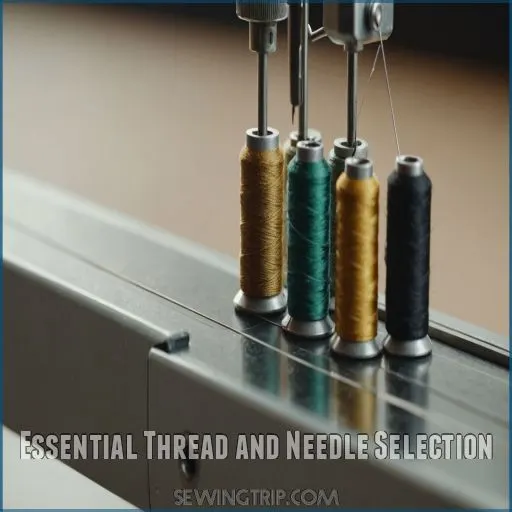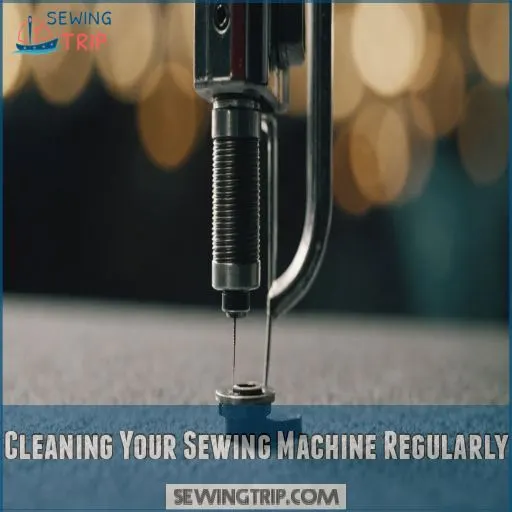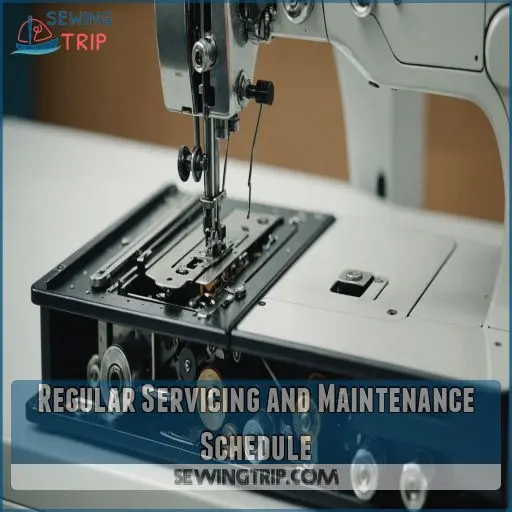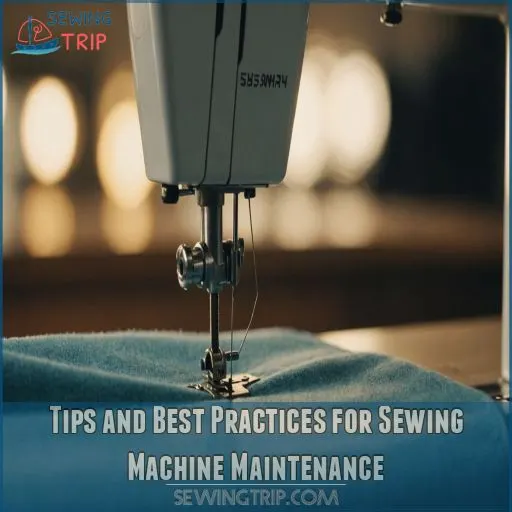This site is supported by our readers. We may earn a commission, at no cost to you, if you purchase through links.
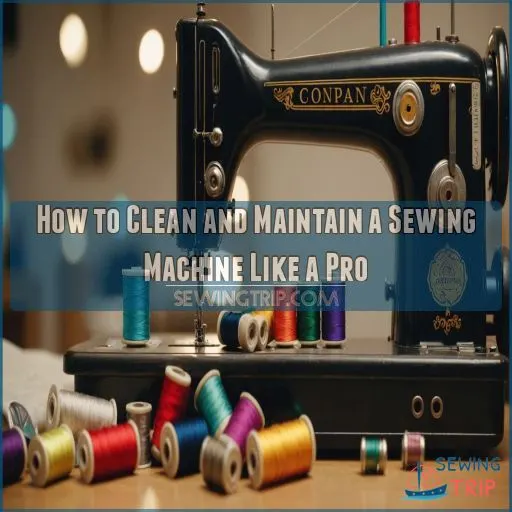
Ditch the canned air, it creates more problems than it solves. Use high-quality threads and needles that match your fabric, and oil your machine with a fine-grade oil like Tri-Flow.
Don’t forget to schedule regular tune-ups with a trusted repair technician. By following these simple tips, you’ll be sewing like a pro in no time.
But that’s just the beginning – what else can you do to keep your machine in top shape?
Table Of Contents
- Key Takeaways
- Essential Thread and Needle Selection
- Cleaning Your Sewing Machine Regularly
- Oiling and Lubricating Your Sewing Machine
- Deep Cleaning and Disassembling Your Machine
- Regular Servicing and Maintenance Schedule
- Tips and Best Practices for Sewing Machine Maintenance
- Frequently Asked Questions (FAQs)
- Conclusion
Key Takeaways
- You’re just a few simple steps away from a sewing machine that runs like a dream – start by cleaning it regularly, and we’re talking about more than just a quick wipe-down. Use a nylon brush to sweep away lint and debris, and avoid using canned air, which can do more harm than good.
- Don’t be afraid to get a little personal with your sewing machine – take it apart and give it a deep clean every now and then. Use a handheld brush, small brushes, and screwdrivers to get into all the nooks and crannies, and consider investing in a sewing machine tool kit to make the process easier.
- Oiling and lubricating your sewing machine is like giving it a spa day – it keeps all the moving parts running smoothly and prevents costly repairs down the line. Look for a fine-grade oil with no additives, and apply it to the designated areas, such as the bobbin housing unit and shuttle hook.
- Remember, a well-maintained sewing machine is a happy sewing machine – so make sure to schedule regular tune-ups and servicing to keep it running smoothly. Find a trusted repair technician, and consider taking your machine in annually for a professional servicing to prevent costly repairs and extend its lifespan.
Essential Thread and Needle Selection
For sewing like a pro, using the right thread and needle for the job is really important.
By choosing high-quality threads and needles that match your fabric and project, you’ll be able to achieve professional-looking results and keep your sewing machine running smoothly.
By making this choice, you ensure that your project turns out as desired and your machine runs without any issues.
Choosing the Right Thread Type
Sewing thread is the real MVP – it holds your project together.
Picking the right thread type is super important. Think about thread weight, sheen, and properties to make sure your project looks great.
For example, use extra-fine thread for delicate fabrics like chiffon or gauze.
Selecting the Best Needle for Your Fabric
You’re about to find the secret to perfect stitches with the right needle for your fabric.
To get started:
- Choose a universal needle for woven fabrics, synthetics, and some knit fabrics.
- Select a ball point needle for rib knits, interlock, and most knit fabrics to prevent running or laddering.
- Pick a metafil needle for metallic or rayon threads on woven or knitted fabrics.
Recommended Thread and Needle Brands
Now that you’ve got the right needle for your fabric, let’s talk thread and needle brands.
| Brand | Description |
|---|---|
| DMC Pearl Cotton No. 8 | Great for hand quilting |
| Schmetz | High-quality needles for various fabrics |
| Groz Beckert | Reliable needles for sewing machines are crucial for preventing bent needles, which can cause skipped stitches, uneven stitch patterns, and fabric puckering. a bent sewing machine needle |
| Organ | Excellent needles for precision sewing |
For thread, consider polyester for low lint and durability.
Maintaining Thread and Needle Quality
After selecting the perfect thread and needle for your sewing projects, it’s time to think about maintaining their quality.
Proper thread storage is key – store threads in a cool, dry place to prevent tangling and fading.
Regularly check your needles for damage and replace them every 8-10 hours of sewing to prevent breakage.
To make sure you can easily replace your needles, learn how to change a sewing machine needle, and choose the right needle type according to your project’s specific requirements.
Such as using universal needles for most fabrics or specialized needles for leather and stretch materials.
Cleaning Your Sewing Machine Regularly
To keep your sewing machine in top shape, cleaning it regularly is a must – think of it like giving your car a tune-up, but instead of oil changes and new spark plugs, you’re dealing with thread bits and lint from easy to use sewing machines
.
By incorporating cleaning into your routine, you’ll be able to prevent problems like jamming, skipping stitches, and even machine breakdowns, ensuring your sewing machine stays in great working condition.
Removing Lint Build-Up and Debris
Cleaning your sewing machine regularly is like giving it a mini-spa day.
Start by removing the needle plate and gently lifting out any big pieces of lint with tweezers (Source).
Use a soft brush to sweep away any remaining debris, making sure to get into all the nooks and crannies, especially around the bobbin area.
Using a Nylon Brush for Effective Cleaning
Time to get up close and personal with your sewing machine’s inner workings.
Grab a nylon brush to gently sweep away lint and debris from the bobbin case and tension discs.
This simple step can make a big difference in your machine’s performance, just like how a quick tidy can boost your productivity.
Avoiding Canned Air and Household Chemicals
Now that you’ve mastered the art of using a nylon brush for effective cleaning, let’s talk about safe alternatives for dust removal.
For lint-free cleaning, avoid using canned air and household chemicals, which can push debris further into your machine.
Instead, try these:
- A handheld brush with secure bristles
- A pipe cleaner and straw for gathering lint
- A micro-tip cleaning brush for reaching small areas
Regular Cleaning Schedule for Optimal Performance
You’ve dodged the canned air and household chemicals – now it’s time to get into a routine. To keep your sewing machine running like new, establish a regular cleaning schedule.
This is especially important since neglecting cleaning can lead to costly repairs and shorten the machine’s lifespan. Regular cleaning also optimizes performance and extends the machine’s life.
| Frequency | Task |
|---|---|
| After every use | Wipe off dust from the machine exterior |
| Every 2-3 bobbins | De-lint the machine using a loop cleaning brush or tweezers |
| After sewing with flannel/minky | Clean immediately |
| Annually | Take your machine in for service |
| As needed | Apply quality oil |
| Every week | Clean the bobbin case and hook area to prevent lint buildup |
Oiling and Lubricating Your Sewing Machine
Oiling and lubricating your sewing machine isn’t just about greasing the wheels – it’s about making sure your machine runs smoothly and efficiently for years to come.
By using the right type of sewing machine oil and applying it to the designated areas, you’ll be able to keep your machine in top condition and prevent costly repairs down the line.
Understanding the Importance of Sewing Machine Oil
After cleaning your sewing machine, it’s essential to oil it to keep the parts running smoothly. Sewing machine oil reduces friction, preventing overheating and damage. Using the right type of oil with the correct viscosity is also crucial for good performance, as specified in the machine’s manual.
This manual usually marks the oiling points, ensuring you apply a drop or two to each designated area, such as after every 8-10 hours of use for regular maintenance, following a regular oiling schedule.
- Keeps your machine running quietly and efficiently
- Prevents wear and tear on moving parts
- Helps maintain consistent stitch quality
- Extends the lifespan of your machine
Choosing the Right Type of Sewing Machine Oil
With a solid understanding of sewing machine oil’s importance, it’s time to pick the right one for your machine.
Look for a fine-grade oil with no additives that can cause varnish buildup, like Tri-Flow.
Avoid 3-in-1 oil, automotive oils, and WD-40.
Consider a low-viscosity oil like mineral oil or baby oil.
Applying Oil to the Designated Areas
Now that you’ve chosen the right type of sewing machine oil, it’s time to apply it to the designated areas of your machine, considering the specific needle compatibility and sizing
. Don’t be shy – your machine needs lubrication to run smoothly.
- The bobbin housing unit
- The shuttle hook
- The metal pot that rubs against the metal when it rotates
- The hook race
Remember to wipe away any excess oil with a cloth and refer to your machine’s manual for specific guidance on oil application areas and frequency (Source).
Running the Machine to Distribute Oil Evenly
As you’ve applied oil to the designated areas, it’s time to run the machine to distribute it evenly.
Turn it on and let it run for a few minutes at a moderate speed.
This will help the oil penetrate all moving parts, reducing friction and ensuring smooth operation .
Deep Cleaning and Disassembling Your Machine
Now that you’ve mastered the basics of cleaning and oiling your sewing machine, it’s time to take it to the next level with a deep clean.
By following these steps, you’ll be able to give your machine the TLC it needs to run smoothly and efficiently.
You’ll be able to extend its lifespan in the process.
Gathering Essential Supplies and Tools
When deep cleaning and disassembling your sewing machine, you’ll need the right supplies and tools.
Invest in a sewing machine tool kit, including a handheld brush, small brushes, screwdrivers, and a pipe cleaner or micro-tip cleaning brushes.
Proper tools for repair and storage solutions will also come in handy.
Disassembling the Machine for Thorough Cleaning
Time to get up close and personal with your sewing machine.
Before taking it apart, make sure you’ve gathered all the necessary tools, including a quality hollow ground screwdriver set.
Remove the motor pulley, bracket, and any other external components to access the internal parts.
Take your time, and work methodically to avoid damaging any parts.
Cleaning the Tension, Head, and Bobbin Case
Now that your sewing machine is disassembled, it’s time to deep clean the tension, head, and bobbin case.
Use these essential tools and tips:
- Tension cleaning tools, like a small brush or cotton swab, to remove lint and debris
- Compressed air to blow out the bobbin area
- A soft cloth to wipe down the head and bobbin case
- A TOWA gauge to check and adjust bobbin case tension
- Regular cleaning frequency to prevent lint buildup
Reassembling and Testing the Machine
Patience is key when reassembling your sewing machine. To make sure the process goes smoothly, refer to the following checklist:
| Component | Reassembly Tips |
|---|---|
| Tension Assembly | Place the thread take-up spring travel adjustment plate over the cup end. Reinstall the assembly into the machine and tighten the set screw (Source). |
| Bobbin Housing | Clean the bobbin housing with a light dry brush and vacuum cleaning. |
| Needle Alignment | Check the needle alignment to make sure the stitch quality is good. |
Remember to test the machine after reassembly to make sure it’s working correctly.
Regular Servicing and Maintenance Schedule
To keep your sewing machine running smoothly, you need to establish a regular servicing and maintenance schedule.
By finding a trusted repair technician, you’ll be able to prevent costly repairs.
This will also improve your machine’s performance, and extend its lifespan.
Finding a Trusted Sewing Machine Repair Technician
Finding the right sewing machine repair technician is important for your machine’s longevity.
When searching, consider the following factors:
- Look for local repair shops with excellent online reviews
- Check the technician’s experience and expertise in repairing your machine’s brand and model
- Ask about repair costs and warranty coverage
- Make sure they use high-quality parts
Scheduling Regular Tune-Ups and Servicing
To keep your sewing machine running smoothly, schedule regular tune-ups and servicing.
| Service Frequency | Recommended Action |
|---|---|
| Every 2-3 months | Clean lint and dust from machine |
| Every 6-12 months | Take machine to a local repair shop for maintenance |
| Every 2 years | Standard check-up and maintenance at a dealership or service center |
Understanding the Cost and Benefits of Servicing
Investing in regular servicing is like giving your sewing machine a health check-up. It can cost between $79 and $129 per visit.
Think of it as a performance boost that extends machine longevity.
A well-maintained machine also preserves warranty validity, saving you from costly DIY mistakes or repairs down the line.
Maintaining a Servicing Schedule for Optimal Performance
Now that you’ve weighed the costs and benefits of servicing, it’s time to schedule regular tune-ups for your sewing machine.
Plan to take your machine in annually for a professional servicing.
Consider DIY cleaning every 2-3 bobbins to prevent lint buildup.
This routine maintenance will extend your sewing machine’s lifespan and prevent costly repairs.
Tips and Best Practices for Sewing Machine Maintenance
By following these simple yet effective tips and best practices for sewing machine maintenance, you’ll be able to keep your machine running smoothly.
Prevent costly repairs, and make sure your projects turn out perfectly every time.
From using high-quality thread and needles to regular cleaning and tension checks, these expert tips will help you master upper thread breaking prevention techniques (upper thread breaking prevention) and become a sewing machine maintenance pro in no time
.
Using High-Quality Thread, Fabric, and Needles
You’ve scheduled your sewing machine’s maintenance, now it’s time to focus on the materials that keep it humming.
Using high-quality thread, fabric, and needles is key to a smooth sewing experience.
Choose the right thread type for your project, and select a needle that suits your fabric’s weight and weave.
Cleaning the Machine After Every Major Project
Every major project you complete is a milestone, but it’s also a reminder to give your sewing machine some TLC.
After a big project, take the time to deep clean your machine.
Paying attention to lint removal, bobbin check, and needle care will keep your machine running smoothly and prevent any potential issues.
Checking and Adjusting Tension Regularly
After completing a major project, take a moment to inspect your stitches.
If they’re uneven or puckered, it’s likely a tension issue.
Check your thread guides, tension discs, and bobbin case for lint and debris.
Proper threading and a well-cleaned machine are key to achieving perfect tension.
Storing the Sewing Machine Properly for Long-Term Use
Now that your sewing machine is running smoothly, it’s time to think about storing it properly for long-term use.
To prevent dust buildup and damage, store your machine in a dry, climate-controlled space.
Consider using a machine cover or dust bag, and avoid storing it in attics or basements with extreme temperatures and humidity.
Frequently Asked Questions (FAQs)
How to maintain a sewing machine?
To keep your sewing machine in top shape, you’ll want to service it annually .
This includes cleaning it regularly, and cleaning or replacing its moving parts.
Additionally, change your needle often, too, to prevent skipped stitches from skipping and threads from breaking.
Do you need to clean your sewing machine?
Your sewing machine needs regular TLC to run smoothly.
De-lint it after every 2-3 bobbins, and take it to a dealer annually for service and maintenance, especially if you sew frequently.
How long does it take to maintain a sewing machine?
Sewing machine maintenance is a breeze – just set aside 10 minutes every 2-3 bobbins to de-lint and clean , and take it to a dealer annually for a thorough service.
Why is maintenance important for a sewing machine?
Regular maintenance is key to keeping your machine running smoothly and prolonging its life.
It’s like giving your car a tune-up – it prevents problems and makes sure it’s performing at its best .
What are the 7 steps in cleaning the sewing machine?
When your sewing machine starts skipping stitches, it’s time to clean the sewing machine lint
.
Change the needle, remove the presser foot, and needle plate.
Then brush out lint, and reassemble in reverse order, every 2-3 bobbins.
How to keep a sewing machine in a good condition?
To keep your sewing machine in top condition, follow a simple routine.
Unplug, remove thread, and clean the machine head, bobbin area, and tension discs.
Also, service it professionally once a year.
How often should a sewing machine be oiled?
Don’t assume your sewing machine is maintenance-free – it needs oil.
As a general rule, oil your machine every few months or annually, depending on usage , but always check your user manual for specific guidance.
Can you service a sewing machine yourself?
You can definitely service your sewing machine yourself with some basic knowledge and maintenance.
Regularly oiling, checking tension, and cleaning can help prevent issues like skipped stitches.
This regular maintenance can also help extend the machine’s lifespan.
What is the average repairing cost of a vintage machine?
Fixing a vintage sewing machine can cost anywhere from zero to hundreds of dollars, depending on the condition and needed repairs.
Why do new home sewing machines cost between $100 and $1000?
New home sewing machines cost between $100 and $
Due to varying features, such as stitch styles and durability.
Typical hobbyists often only use basic patterns, making some machines better value than others.
Can I transfer designs to my embroidery machine without software?
Transfer designs to your embroidery machine without software using a wireless SD card, like FlashAir.
Or the EmbroideryConnect WiFi Device, which works with various machines and allows for seamless, cable-free transfer.
How do I date an antique New Home sewing machine?
Unravel the mystery of your antique New Home sewing machine by checking the serial number, patent dates, and model numbers.
to estimate its age, like the ones listed on.
Where are Janome sergers, sewing and embroidery machines manufactured?
Janome’s sergers, sewing, and embroidery machines are manufactured across three countries: top-range models in Tokyo, mid-range in Taiwan, and popular-range in Thailand.
Conclusion
What’s the secret to a sewing machine that hums like a well-oiled machine – literally?
By following these simple yet important steps, you’ll be well on your way to mastering the art of sewing machine maintenance and troubleshooting common issues like sewing machine tension fixing thread tension secrets
.
From essential thread and needle selection to regular cleaning and oiling, you’ve got the know-how to keep your machine running smoothly.
Remember, learning how to clean and maintain a sewing machine like a pro takes time and practice, but the payoff is well worth it – happy sewing.

